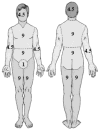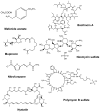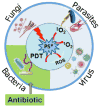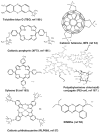Topical antimicrobials for burn wound infections
- PMID: 20429870
- PMCID: PMC2935806
- DOI: 10.2174/157489110791233522
Topical antimicrobials for burn wound infections
Abstract
Throughout most of history, serious burns occupying a large percentage of body surface area were an almost certain death sentence because of subsequent infection. A number of factors such as disruption of the skin barrier, ready availability of bacterial nutrients in the burn milieu, destruction of the vascular supply to the burned skin, and systemic disturbances lead to immunosuppression combined together to make burns particularly susceptible to infection. In the 20th century the introduction of antibiotic and antifungal drugs, the use of topical antimicrobials that could be applied to burns, and widespread adoption of early excision and grafting all helped to dramatically increase survival. However the relentless increase in microbial resistance to antibiotics and other antimicrobials has led to a renewed search for alternative approaches to prevent and combat burn infections. This review will cover patented strategies that have been issued or filed with regard to new topical agents, preparations, and methods of combating burn infections. Animal models that are used in preclinical studies are discussed. Various silver preparations (nanocrystalline and slow release) are the mainstay of many approaches but antimicrobial peptides, topical photodynamic therapy, chitosan preparations, new iodine delivery formulations, phage therapy and natural products such as honey and essential oils have all been tested. This active area of research will continue to provide new topical antimicrobials for burns that will battle against growing multidrug resistance.
Conflict of interest statement
None
Figures














References
-
- Sharma BR, Harish D, Singh VP, Bangar S. Septicemia as a cause of death in burns: an autopsy study. Burns. 2006 Aug;32(5):545–9. - PubMed
-
- Monafo WW. Then and now: 50 years of burn treatment. Burns. 1992;18(Suppl 2):S7–10. - PubMed
-
- Malic CC, Karoo RO, Austin O, Phipps A. Resuscitation burn card--a useful tool for burn injury assessment. Burns. 2007;33(2):195–9. - PubMed
-
- Robins EV. Burn shock. Crit Care Nurs Clin North Am. 1990;2(2):299–307. - PubMed
Publication types
MeSH terms
Substances
Grants and funding
LinkOut - more resources
Full Text Sources
Other Literature Sources
Medical
